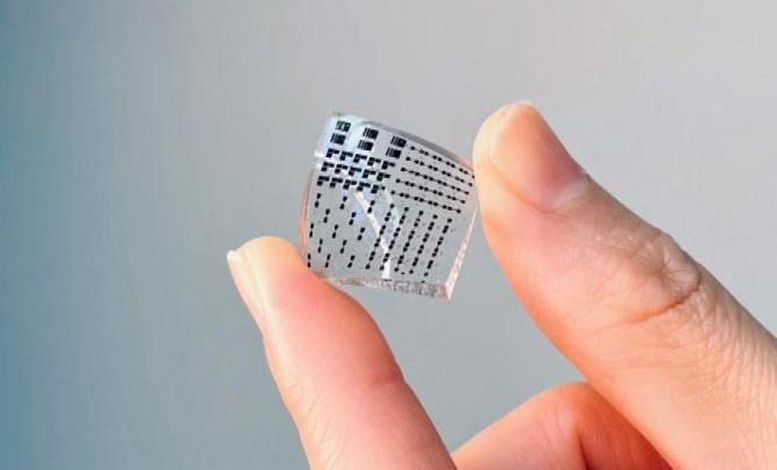Robotic Care: The Future of Touch with Stretchable E-Skin | by Oluwafemidiakhoa | May, 2024

In an era where technological advancements shape our daily lives, the field of robotics stands at the forefront, transforming industries and improving human experiences. One such transformative innovation is stretchable electronic skin, commonly known as e-skin. This groundbreaking technology aims to endow robots with a tactile sense akin to human touch, revolutionizing their interaction capabilities and enhancing their functionality across various domains.
Stretchable e-skin is a sophisticated blend of materials science, electronics, and robotics engineering. Unlike traditional rigid sensors, e-skin is designed to be flexible, durable, and highly sensitive, closely mimicking the properties of human skin. This innovation opens new frontiers for robots, particularly in healthcare, where the sense of touch is paramount.
In healthcare, the human touch is not just about physical contact but also about conveying empathy, providing reassurance, and ensuring precision in medical procedures. The development of e-skin for robots presents a unique opportunity to merge advanced technology with the compassionate aspects of human care. From assisting surgeons in delicate operations to offering a comforting touch to patients, e-skin-equipped robots hold the promise of enhancing the quality of healthcare delivery.
This article delves into the development of stretchable electronic skin, exploring its scientific foundations, engineering breakthroughs, and the vast potential applications in healthcare. By understanding the evolution of this technology and its implications, we can better appreciate how e-skin might shape the future of robotic care, making it more human-like, precise, and emotionally intelligent.
As we embark on this journey, we will uncover how e-skin transforms robots from mere mechanical entities into empathetic assistants, poised to redefine the dynamics of patient care and medical practices.
The journey of tactile technology in robotics has been marked by a series of remarkable advancements, each bringing robots closer to achieving human-like touch sensitivity. This chapter traces the history of these developments, from the rudimentary beginnings to the sophisticated stretchable electronic skin (e-skin) we see today.
Early Tactile Sensors
The initial forays into robotic touch began with simple pressure sensors. These early tactile sensors, often made from piezoelectric materials, could detect basic touch and pressure. While these sensors were revolutionary at the time, their applications were limited due to their rigidity and lack of sensitivity.
In the 1980s, researchers began exploring more complex tactile systems. One of the significant milestones was the development of capacitive sensors. These sensors could measure changes in capacitance caused by contact with an object, providing more detailed information about the nature of the touch. However, capacitive sensors still faced challenges in terms of flexibility and durability, making them less ideal for applications requiring dynamic movements.
Advances in Tactile Sensing
The 1990s and early 2000s saw significant progress in the miniaturization and integration of tactile sensors. The advent of microelectromechanical systems (MEMS) technology allowed for the creation of smaller, more sensitive sensors that could be embedded into robotic hands and fingers. These MEMS-based sensors improved the robots’ ability to manipulate objects and perform tasks that required a delicate touch.
During this period, researchers also began experimenting with different materials and sensor configurations. Polymer-based sensors, for instance, provided greater flexibility and could be molded into various shapes. These innovations paved the way for more advanced tactile systems that could better mimic the human sense of touch.
The Birth of E-Skin
The concept of electronic skin, or e-skin, emerged in the early 2010s, representing a significant leap forward in tactile technology. E-skin combines flexible electronics with stretchable materials to create a sensor network that can cover large surfaces and conform to complex shapes. This development marked the beginning of a new era in robotic touch.
E-skin technology is inspired by the human skin, which is not only flexible and stretchable but also capable of sensing multiple stimuli simultaneously. To achieve similar properties, researchers have developed innovative materials such as silicone-based elastomers and conductive polymers. These materials can stretch and bend without losing their electrical properties, making them ideal for e-skin applications.
Key Milestones in E-Skin Development
One of the early breakthroughs in e-skin technology was the development of pressure-sensitive rubber by a team of Japanese researchers. This material could detect pressure changes with high sensitivity, laying the foundation for future e-skin innovations.
In 2013, a significant advancement came with the creation of a transparent, stretchable e-skin by researchers at the University of Tokyo. This e-skin could measure pressure, temperature, and humidity, providing a comprehensive sensory input similar to human skin. The use of organic transistors and carbon nanotubes in this e-skin demonstrated the potential of combining nanotechnology with flexible electronics.
Another milestone was achieved in 2018 when a team at Stanford University developed an e-skin capable of self-healing. This self-healing property, inspired by biological systems, addresses one of the major challenges in e-skin technology — durability. The self-healing e-skin can recover from mechanical damage, significantly extending its lifespan and reliability.
The Integration with Robotics
Integrating e-skin with robotic systems presents its own set of challenges and opportunities. One of the critical aspects is ensuring seamless communication between the e-skin and the robot’s control system. Advanced algorithms and machine learning techniques are employed to interpret the sensory data from the e-skin and translate it into actionable commands for the robot.
Robots equipped with e-skin can perform tasks that require a nuanced touch, such as handling fragile objects, assisting in surgeries, and providing physical therapy to patients. The tactile feedback from the e-skin allows robots to adjust their grip and movements in real time, enhancing their precision and effectiveness.
Future Directions
The evolution of robotic touch is far from complete. Future research aims to improve the sensitivity, durability, and scalability of e-skin. Researchers are also exploring the integration of additional sensory modalities, such as chemical and biological sensors, to further enhance the capabilities of e-skin.
As e-skin technology continues to advance, it holds the potential to transform various industries beyond healthcare, including manufacturing, space exploration, and personal robotics. The ultimate goal is to create robots that can interact with their environment and humans in a more natural and intuitive way, bridging the gap between machines and humans.
In the next chapter, we will delve deeper into the science behind stretchable e-skin, exploring the materials, engineering innovations, and the intricate design that makes this technology possible.
The development of stretchable electronic skin (e-skin) is a marvel of modern materials science and engineering. To understand how e-skin can mimic the properties of human skin, it is essential to delve into the components, structure, and underlying technologies that make this innovation possible. This chapter explores the materials, design principles, and engineering challenges involved in creating stretchable e-skin.
Materials for E-Skin
The choice of materials is crucial in the development of e-skin. These materials need to be flexible, stretchable, and capable of conducting electricity. The following are some of the primary materials used in e-skin:
- Silicone-Based Elastomers: Silicone rubber is one of the most common materials used in e-skin due to its excellent flexibility, biocompatibility, and ease of processing. It can stretch significantly without losing its structural integrity, making it ideal for applications requiring conformability to complex surfaces.
- Conductive Polymers: These polymers, such as polypyrrole and polyaniline, offer flexibility combined with electrical conductivity. They are often used in combination with other materials to create composite structures that can stretch and conduct electrical signals.
- Carbon Nanotubes (CNTs): CNTs are cylindrical nanostructures with exceptional mechanical strength, electrical conductivity, and flexibility. They are often incorporated into polymer matrices to enhance the electrical and mechanical properties of e-skin.
- Metal Nanowires: Silver and gold nanowires are used to create networks that can stretch and bend while maintaining electrical conductivity. These networks are embedded in elastic substrates to form the conductive pathways in e-skin.
- Hydrogels: Hydrogels are water-based gels that can be engineered to be both flexible and conductive. They are particularly useful for creating sensors that can detect changes in pressure, temperature, and humidity.
Design and Structure
The design of e-skin involves creating a multilayered structure that can house various sensors while maintaining flexibility and durability. A typical e-skin structure includes the following layers:
- Substrate Layer: This is the base layer, usually made of a flexible and stretchable material like silicone rubber or polyurethane. It provides mechanical support and flexibility to the entire e-skin.
- Sensor Layer: This layer contains the sensors that detect various stimuli. These sensors can be made from conductive polymers, metal nanowires, or other materials that can change their electrical properties in response to external stimuli.
- Interconnect Layer: This layer includes the conductive pathways that connect the sensors to the electronic circuitry. It is often made from stretchable conductive materials like metal nanowire networks or conductive inks.
- Encapsulation Layer: To protect the sensors and interconnects from environmental factors, an encapsulation layer is added. This layer is typically made from a stretchable and biocompatible material that can shield the e-skin from moisture, dust, and mechanical damage.
Sensor Technologies
The sensors embedded in e-skin are responsible for detecting various types of stimuli, such as pressure, temperature, and humidity. Here are some of the key sensor technologies used in e-skin:
- Pressure Sensors: These sensors can detect changes in pressure by measuring variations in capacitance, resistance, or piezoelectricity. Capacitive pressure sensors measure changes in capacitance caused by the deformation of the sensor material. Resistive pressure sensors measure changes in resistance when the material is compressed. Piezoelectric sensors generate an electrical charge in response to mechanical stress.
- Temperature Sensors: Temperature sensors in e-skin typically rely on thermistors or thermocouples. Thermistors change their resistance with temperature, while thermocouples generate a voltage based on the temperature difference between two junctions.
- Humidity Sensors: These sensors measure the amount of moisture in the environment. They often use materials that change their electrical properties (such as capacitance or resistance) in response to humidity levels.
- Strain Sensors: Strain sensors detect deformation or stretching of the e-skin. They are usually based on materials that change their resistance or capacitance when stretched. This allows the e-skin to measure movements and deformations accurately.
Integration with Robotics
Integrating e-skin with robotic systems involves several engineering challenges. The e-skin must communicate effectively with the robot’s control system, interpret sensory data accurately, and respond in real time. The following are some key aspects of this integration:
- Signal Processing: The raw data from the e-skin sensors must be processed to extract meaningful information. Advanced signal processing algorithms are used to filter noise, calibrate the sensors, and interpret the data.
- Data Communication: The sensory data from the e-skin needs to be transmitted to the robot’s central processing unit (CPU). This requires robust and efficient communication protocols that can handle large amounts of data in real time.
- Control Algorithms: Once the data is received and processed, control algorithms are used to translate the sensory input into actions. For example, if the e-skin detects increased pressure, the robot may need to adjust its grip to avoid damaging an object.
- Power Management: E-skin requires a reliable power source to operate its sensors and communication modules. Efficient power management systems are necessary to ensure the e-skin can function for extended periods without frequent recharging or battery replacement.
Challenges and Future Directions
While significant progress has been made in the development of e-skin, several challenges remain:
- Durability: E-skin must withstand repeated stretching, bending, and environmental exposure without degrading. Researchers are exploring self-healing materials and more robust encapsulation techniques to address this issue.
- Scalability: Producing e-skin on a large scale with consistent quality is challenging. Advances in manufacturing techniques, such as roll-to-roll printing, are being investigated to enable mass production of e-skin.
- Multi-Functionality: Integrating multiple types of sensors into a single e-skin without compromising its flexibility and performance is complex. Future e-skin designs aim to incorporate additional sensory modalities, such as chemical and biological sensors.
- Human-Robot Interaction: Ensuring that robots equipped with e-skin can interact with humans safely and intuitively is a key goal. This involves developing more sophisticated algorithms for interpreting sensory data and controlling robotic actions.
As research and development continue, the potential applications of e-skin will expand, transforming not only healthcare but also other industries such as manufacturing, space exploration, and personal robotics. In the next chapter, we will explore the specific applications of e-skin in healthcare, from assisting in surgeries to providing enhanced patient care with human-like touch sensitivity.
As stretchable electronic skin (e-skin) continues to evolve, the potential for future innovations and applications grows exponentially. This chapter explores the future directions and research prospects for e-skin technology, highlighting the interdisciplinary collaborations and technological advancements that will shape the next generation of e-skin.
Advances in Material Science
Material science plays a crucial role in the development of e-skin. Future research will focus on creating new materials that enhance the functionality, durability, and scalability of e-skin.
- Self-Healing Materials: One of the most exciting prospects in e-skin research is the development of self-healing materials. These materials can automatically repair themselves when damaged, extending the lifespan and reliability of e-skin. Researchers are exploring various approaches, including the use of polymers that can form new bonds when broken and the incorporation of microcapsules filled with healing agents.
- Biodegradable Materials: Environmental sustainability is an important consideration for future e-skin development. Biodegradable materials that can decompose naturally after use will help reduce the environmental impact of e-skin devices. These materials will be particularly useful for disposable medical applications and wearable electronics.
- Nanocomposite Materials: The integration of nanomaterials, such as carbon nanotubes and graphene, into e-skin can significantly enhance its mechanical and electrical properties. These nanocomposite materials can provide higher sensitivity, flexibility, and conductivity, enabling more advanced and reliable e-skin sensors.
Enhanced Sensing Capabilities
The future of e-skin technology will see the incorporation of additional sensing modalities, making e-skin even more versatile and useful in a wide range of applications.
- Multimodal Sensing: Future e-skin designs will integrate multiple types of sensors to detect a variety of stimuli simultaneously. For example, e-skin could combine pressure, temperature, humidity, and chemical sensors to provide comprehensive environmental monitoring. This multimodal sensing capability will be valuable in applications such as healthcare, environmental monitoring, and industrial automation.
- Bioelectronic Interfaces: E-skin can be developed to interface directly with biological systems, enabling real-time monitoring of physiological signals. Bioelectronic e-skin can measure biomarkers such as glucose levels, pH, and metabolites, providing valuable data for managing chronic diseases and personalized healthcare.
- Wireless Communication: Integrating wireless communication modules into e-skin will allow for real-time data transmission to remote devices and cloud-based platforms. This will enable continuous monitoring and analysis of sensor data, facilitating timely interventions and data-driven decision-making.
Integration with Artificial Intelligence
The combination of e-skin with artificial intelligence (AI) will open new avenues for smart and adaptive systems that can learn from sensory data and make autonomous decisions.
- Machine Learning Algorithms: AI algorithms can analyze the vast amounts of data generated by e-skin sensors, identifying patterns and anomalies that may not be apparent to humans. Machine learning can enhance the accuracy and predictive capabilities of e-skin applications, such as early detection of health conditions and predictive maintenance in industrial settings.
- Robotic Learning: E-skin-equipped robots can use AI to improve their performance over time. By learning from sensory feedback, robots can adapt their actions to different tasks and environments. For example, a robot can learn to adjust its grip based on the texture and shape of objects, improving its ability to handle a wide range of materials.
- Context-Aware Systems: AI can enable e-skin to interpret sensory data in context, providing more relevant and actionable insights. Context-aware systems can adjust their responses based on the environment and the specific needs of users. For example, an e-skin-equipped healthcare robot can modify its touch based on the patient’s condition and preferences.
Interdisciplinary Collaborations
The future of e-skin technology will be driven by interdisciplinary collaborations that bring together experts from various fields, including materials science, electronics, robotics, healthcare, and AI.
- Collaborative Research: Universities, research institutions, and industry partners will work together to address the complex challenges of e-skin development. Collaborative research initiatives can leverage diverse expertise and resources to accelerate innovation and bring new solutions to market
- Industry Partnerships: Partnerships between e-skin developers and industry stakeholders will be crucial for the commercialization and adoption of e-skin technology. Industry partners can provide valuable insights into market needs, regulatory requirements, and practical applications, ensuring that e-skin products are aligned with user demands.
- Funding and Support: Government agencies, private investors, and philanthropic organizations will play a key role in supporting e-skin research and development. Funding and support from these entities can help overcome financial and technical barriers, enabling the translation of e-skin innovations from the lab to real-world applications.
Ethical and Societal Implications
As e-skin technology advances, it is important to consider the ethical and societal implications of its use. Addressing these issues will ensure that e-skin is developed and deployed responsibly.
- Privacy and Security: The use of e-skin in wearable devices and healthcare applications raises concerns about data privacy and security. Ensuring that user data is protected and that e-skin devices are secure from cyber threats will be essential to maintaining trust and safeguarding sensitive information.
- Equity and Accessibility: Making e-skin technology accessible to all individuals, regardless of socioeconomic status, is crucial for ensuring its benefits are widely shared. Efforts should be made to reduce costs and improve accessibility, particularly for applications in healthcare and assistive devices.
- Human-Robot Interaction: As e-skin-equipped robots become more prevalent, it is important to consider the impact on human-robot interactions. Ensuring that robots complement human caregivers rather than replacing them, and that they are used in ways that enhance human well-being, will be key to ethical deployment.
The future directions and research prospects for e-skin technology are vast and exciting. Advances in material science, enhanced sensing capabilities, integration with AI, interdisciplinary collaborations, and consideration of ethical and societal implications will drive the next generation of e-skin.
As e-skin continues to evolve, it will unlock new possibilities across various industries, transforming how we interact with technology and improving the quality of life. By embracing innovation and collaboration, we can harness the full potential of e-skin to create a smarter, more responsive, and empathetic world.
In the final chapter, we will summarize the key points discussed throughout this article and reflect on the transformative impact of e-skin technology on robotics and healthcare, envisioning a future where e-skin becomes an integral part of our daily lives.
The development of stretchable electronic skin (e-skin) marks a significant milestone in the evolution of robotics and sensor technology. This comprehensive article has explored the multifaceted applications of e-skin, from enhancing healthcare delivery to transforming industries such as manufacturing, space exploration, and consumer electronics. As we conclude, it is essential to reflect on the transformative impact of e-skin technology and envision the future it holds.
Recap of Key Points
Throughout this article, we have delved into various aspects of e-skin technology:
- Introduction to E-Skin: We introduced the concept of e-skin and its relevance in modern robotics and healthcare. E-skin mimics the properties of human skin, offering flexibility, durability, and sensitivity, thereby enhancing the tactile capabilities of robots.
- Evolution of Robotic Touch: We traced the history of tactile technology in robotics, highlighting key milestones and advancements that paved the way for the development of e-skin. From early pressure sensors to sophisticated e-skin materials, the journey of robotic touch has been marked by continuous innovation.
- Science Behind E-Skin: We explored the materials, design principles, and engineering challenges involved in creating e-skin. Key components include silicone-based elastomers, conductive polymers, carbon nanotubes, and metal nanowires, which together enable the stretchability and sensitivity of e-skin.
- E-Skin in Healthcare: We examined the transformative applications of e-skin in healthcare, including surgical assistance, patient monitoring, and empathetic care. E-skin-equipped robots can enhance surgical precision, provide continuous health monitoring, and offer human-like touch to improve patient care.
- Broader Applications: Beyond healthcare, e-skin technology has the potential to revolutionize manufacturing, space exploration, personal robotics, and consumer electronics. E-skin enhances the functionality, safety, and efficiency of robots and wearable devices across various industries.
- Future Directions: We discussed the future directions and research prospects for e-skin technology. Advances in material science, enhanced sensing capabilities, integration with AI, and interdisciplinary collaborations will drive the next generation of e-skin. Ethical considerations and efforts to ensure equity and accessibility are also critical for responsible development.
Transformative Impact
E-skin technology represents a change in basic assumptions in how we interact with machines and the environment. By endowing robots with a sense of touch, e-skin enables more intuitive and responsive interactions, bridging the gap between humans and machines. This has profound implications for various fields:
- Healthcare: In healthcare, e-skin-equipped robots can assist in surgeries, monitor patients continuously, and provide empathetic care. This technology enhances precision, efficiency, and emotional connection in medical practice, improving patient outcomes and quality of care.
- Industrial Automation: In manufacturing and industrial settings, e-skin enhances the capabilities of robots, enabling them to perform delicate and complex tasks with greater accuracy. This improves product quality, reduces waste, and enhances safety in hazardous environments.
- Exploration and Research: In space exploration and scientific research, e-skin-equipped robots can gather detailed sensory data, perform maintenance tasks, and support astronauts. This technology expands our capabilities for exploration and experimentation in challenging environments.
- Everyday Life: In personal robotics and consumer electronics, e-skin enhances user experience by providing more natural and intuitive touch interactions. From assistive robots to smart clothing and wearable health monitors, e-skin technology integrates seamlessly into daily life, offering convenience and improved functionality.
Envisioning the Future
Looking ahead, the continued evolution of e-skin technology will bring even more innovative applications and benefits. The integration of AI and advanced materials will further enhance the capabilities of e-skin, making robots and devices smarter, more adaptive, and more responsive.
The future of e-skin is not limited to enhancing existing technologies; it also opens the door to entirely new possibilities. Imagine a world where robots equipped with e-skin can provide personalized care to the elderly, assist in disaster relief efforts with unparalleled sensitivity, or even explore distant planets with the ability to sense and analyze their surroundings in real-time.
As researchers, engineers, and industry leaders continue to push the boundaries of what is possible, e-skin technology will undoubtedly play a central role in shaping the future of human-machine interaction. By embracing the potential of e-skin, we can create a world where technology is more attuned to our needs, enhancing our lives in ways we have yet to fully imagine.
Final Thoughts
Stretchable electronic skin represents a fusion of advanced materials science, electronics, and robotics engineering, offering a glimpse into the future of touch and interaction. Its applications in healthcare, industry, exploration, and everyday life highlight the transformative potential of this technology. As we continue to innovate and collaborate across disciplines, the future of e-skin technology promises to be both exciting and impactful, paving the way for a smarter, more connected, and more empathetic world.
By envisioning the future and addressing the challenges ahead, we can harness the power of e-skin to create a better, more responsive, and more human-centered technological landscape. The journey of e-skin has just begun, and its potential is boundless.
Further Reading
- “Stretchable Electronics: Fabrication Technologies and Applications” by Takao Someya
- This book provides an in-depth look at the technologies and methods used to create stretchable electronics, including e-skin. It covers material properties, fabrication techniques, and applications in various fields.
2. “Robotic Tactile Sensing: Technologies and System” by Huosheng Hu and Manjiri Joshi
- This comprehensive guide explores the different technologies and systems used in robotic tactile sensing, offering detailed insights into the development and application of tactile sensors and e-skin.
3. “Flexible and Stretchable Medical Devices” edited by John A. Rogers and Roozbeh Ghaffari
- This book focuses on the development and application of flexible and stretchable devices in the medical field, highlighting the role of e-skin in advancing healthcare technologies.
4. “Artificial Intelligence for Robotics” by Francis X. Govers
- This book covers the integration of AI with robotics, providing insights into how AI algorithms can enhance the capabilities of e-skin-equipped robots.
5. “Tactile Sensing, Skill Learning, and Robotic Dexterous Manipulation” edited by Qiang Li, Shuo Liu, and Kaiwen Hu
- This collection of research papers discusses the latest advancements in tactile sensing and robotic manipulation, including the role of e-skin in improving robotic dexterity and precision.
References
- Kim, D. H., et al. (2011). “Epidermal Electronics.” Science, 333(6044), 838–843.
- This seminal paper discusses the development of epidermal electronics, a precursor to modern e-skin technologies, focusing on the materials and techniques used to create flexible, wearable sensors.
2. Hammock, M. L., et al. (2013). “25th Anniversary Article: The Evolution of Electronic Skin (E-Skin): A Brief History, Design Considerations, and Recent Progress.” Advanced Materials, 25(42), 5997–6038.
- This article provides a comprehensive overview of the evolution of e-skin, including historical developments, design principles, and recent advancements in the field.
3. Cao, Y., et al. (2018). “Self-healing Electronic Skin (E-Skin) for Robotic and Wearable Applications.” Science Robotics, 3(19), eaat1731.
- This research paper explores the development of self-healing e-skin, highlighting its potential applications in robotics and wearable technology.
4. Takei, K., et al. (2010). “Nanowire Active-Matrix Circuitry for Low-Voltage Macroelectronics.” Nature Materials, 9(10), 821–826.
- This study focuses on the use of nanowires in creating flexible and stretchable electronic circuits, a key component of e-skin technology.
5. Miyamoto, A., et al. (2017). “Inflammation-Free, Gas-Permeable, Lightweight, Stretchable On-Skin Electronics with Nanomeshes.” Nature Nanotechnology, 12(10), 907–913.
- This paper presents the development of nanomesh-based on-skin electronics, which contribute to the advancement of e-skin by providing lightweight and breathable sensor materials.
6. Liu, Y., et al. (2019). “E-Skin: From Humanoids to Humans.” Proceedings of the IEEE, 107(10), 2015–2033.
- This review article discusses the application of e-skin in both humanoid robots and human healthcare, providing insights into the potential benefits and challenges of integrating e-skin into various systems.
7. Javey, A., & Rogers, J. A. (2006). “Stretchable Electronics.” Nature Materials, 6(10), 855–861.
- This foundational paper explores the materials and techniques used to create stretchable electronics, laying the groundwork for future developments in e-skin technology.
8. Wang, X., et al. (2018). “Flexible and Stretchable Triboelectric Nanogenerators for Self-Powered Electronic Skin.” Advanced Materials, 30(21), 1706749.
- This research explores the use of triboelectric nanogenerators in creating self-powered e-skin, highlighting the potential for energy-harvesting sensors in wearable and robotic applications.
9. Someya, T., & Amagai, M. (2019). “Toward a New Generation of Smart Skins.” Nature Biotechnology, 37(4), 382–388.
- This article discusses the future prospects of smart skin technologies, including e-skin, emphasizing the potential impact on healthcare, robotics, and beyond.
These references and further reading materials provide a solid foundation for understanding the development, applications, and future directions of stretchable electronic skin technology. They offer insights into the scientific principles, engineering challenges, and interdisciplinary collaborations that drive this innovative field.



